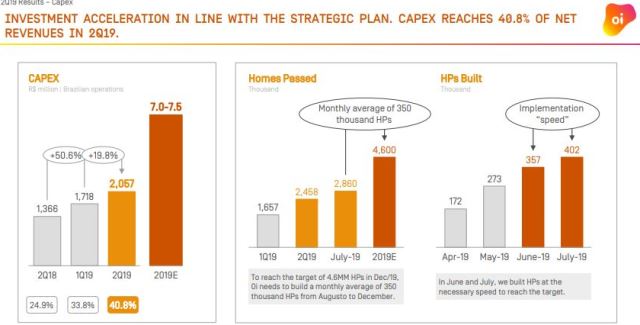Oi Chief Financial Officer Carlos Brandao said the telecom operator is targeting to spend around R$7.5 billion towards capital expenditure (Capex) in 2019.

The annual capital expenditure of Oi will be around R$7 billion in 2020.
Oi’s Capex rose 50.7 percent year-on-year and 19.5 quarter-on-quarter to R$ 2.061 billion in Q2 2019. Capex of Oi in Brazil, its home market, touched R$ 2.057 billion, increasing 50.6 percent year-on-year and 19.5 percent quarter-on-quarter.
The investment strategy of Oil was in the rapid expansion of FTTH, 4G and 4.5G projects in Brazil. Oi closed Q2 with 2.5 million homes passes and more than 237K homes connected.
Oi reached 2.5 million homes passed (HPs), 800K of which built in the second quarter. The company has the capacity to build more than 350K homes passed per month. Oi aims to reach 4.6 million homes passed by the end of 2019 and 16 million homes passed by the end of 2021.
Oi closed H1 2019 with over 237K homes connected (HCs) to the fiber and a take-up rate of 9.7 percent. Oi Fibra is present in 59 municipalities. Oi currently has over 360,000 kilometers of fiber in Brazil.
Oi’s 2G reached 3,451 municipalities or 93 percent of the urban population. Oi’s 3G reached 1,644 municipalities or 82 percent of urban population. Oi’s 4G reached 907 municipalities or 74 percent of Brazil’s urban population. 4.5G reached 34 municipalities or 12 percent of the urban population.

Oi lost customers
Oi lost 1,775K connections – a loss of 3,275K prepaid subscribers and an addition of 1,500K post-paid subscribers — between Q2 2018 and Q2 2019.
Oi lost residential broadband customers at 9.1 percent year-on-year and 2.3 percent quarter-on-quarter to reach 14,011K, mainly due to the reduction in both the copper broadband and the fixed line customer bases.
Oi also lost residential fixed line customers registering drop of 11.9 percent year-on-year and 2.9 percent quarter-on-quarter to reach 7,770K.
Oi’s fixed broadband customer base dropped 7.5 percent year-on-year and 1.8 percent quarter-on-quarter to 4,672K.
The percentage of fixed line customers who also have broadband reached 60.1 percent, an all-time high. Oi business management team followed the strategy of selling voice, data and pay-TV bundles.
Oi Pay TV base grew 1.6 percent year-on-year and dropped 0.3 percent quarter-on-quarter to 1,569K connections. Oi TV’s penetration in households with an Oi fixed line reached 20.2 percent.
Oi reported revenues dropped 8.2 percent y-on-y and 0.8 percent q-o-q to R$5.091 billion in Q2. Revenues from Brazil were R$ 5,046 million, showing 8.1 percent dip y-o-y and 0.8 percent decrease q-o-q. Oi’s revenues from international operations in Africa and East Timor dropped 18.5 percent y-o-y and increased 2.6 percent q-o-q to R$ 45 million.





